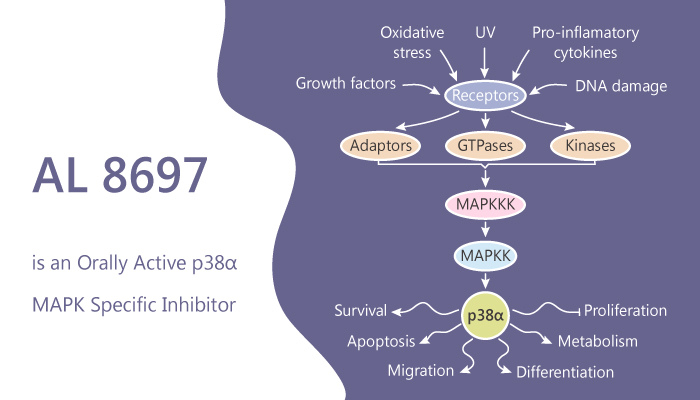A wide range of cellular stresses can activate mammalian p38 MAPKs, or it is in response to inflammatory cytokines. The p38 MAPK subfamily can further be divided into two distinct subsets. On the one hand, they are p38α and p38β and on the other are p38γ and p38δ. They are about 60% identical in their amino acid sequence. But, they are differ in their expression patterns, substrate specificities and sensitivities to chemical inhibitors such as SB203580. However, the best characteristic and expression in most cell types is p38α. The p38α MAPK is an intracellular serine/threonine (Ser/Thr) kinase.
In its activated state, p38a phosphorylates a range of intracellular protein substrates that post-transcriptionally regulate the biosynthesis of TNFα and IL-1β. Excessive levels of TNFα and IL-1β may be responsible for the progression of many inflammatory diseases such as rheumatoid arthritis, psoriasis and inflammatory bowel disease.
AL 8697 is a specific p38α inhibitor with an IC50 of 6 nM. Moreover, it displays 14-fold less potent in p38β (IC50 = 82 nM), and at least 300-fold more selective in a panel of 91 kinases. In addition, AL 8697 exhibits anti-inflammatory activity.

In vivo, male Wistar rats administer AL 8697 once daily over the 10 day adjuvant-induced arthritis study period. AL 8697 dose-dependently decreases the oedema in right and left paws, causing a larger improvement in the contralateral un-injected paw. AL 8697 reaches an efficacy plateau around 80% inhibition at the highest doses. It is a measure of the anti-inflammatory activity in this study. Thus, AL 8697 shows a good anti-inflammatory effect.
According to the studies of preclinical and clinical, AL 8697 exhibits a complex profile, and inhibition of p38 produces a better anti-inflammatory effect on the ipsilateral-induced paw oedema.
Reference:
Balagué C, et al. Br J Pharmacol. 2012 Jun;166(4):1320-32.